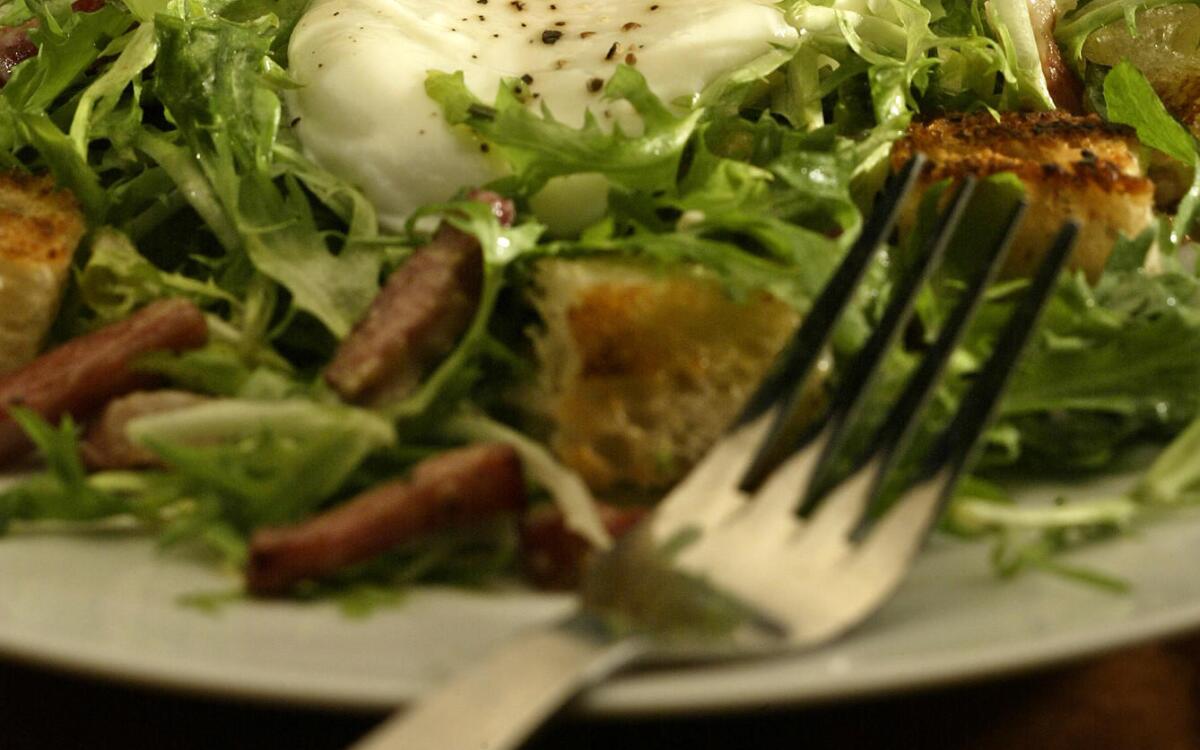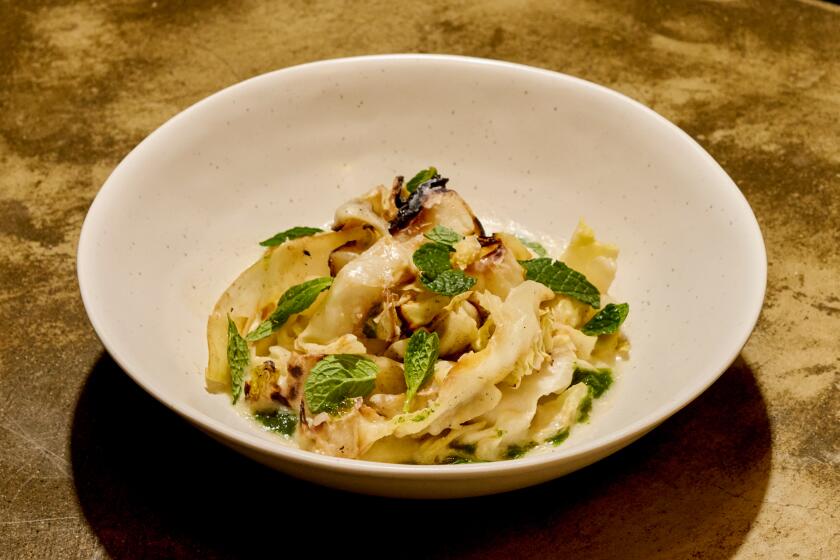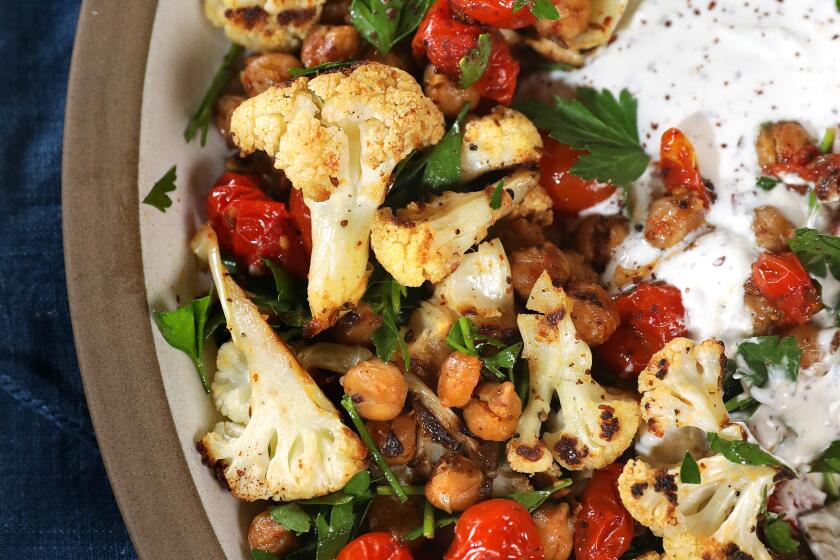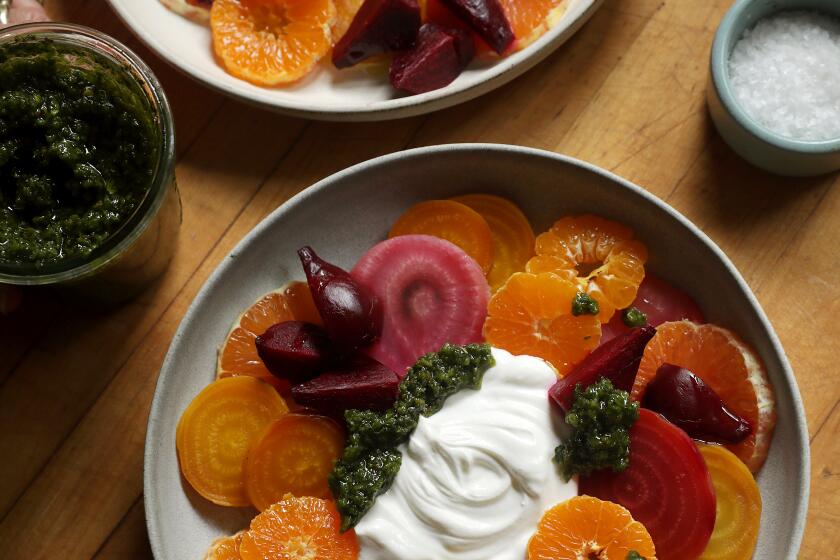Classic frisee salad

Lately you can’t pick up a food magazine without coming across another ode to bacon, which really is one of the most seductive ingredients ever cured. But there’s more to the story than the American way of frying. Now that detente has been declared with Old Europe, it’s safe to say one thing for the French: They do bacon right.
Rather than restricting themselves to crisp strips or crumbled bits in sandwiches or salads, the cheese-eating freedom fryers know the best bites are actually chunks. Or cubes. Or slabs. Their idea of bacon is chewy and succulent, with more flavor than fat. And they unflinchingly label it lardon.
Anyone who has ever eaten a classic salade frisee oozing with egg knows exactly why lardons exist. The thick strips (pronounced LAHR-dohns) are the perfect complement to the bitter greens and crunchy croutons. Bacon in a spinach-mushroom salad mostly adds texture, maybe a little smokiness. Lardons bring the other elements into rich coherence.
Flavor foundation
The name comes from the verb “to lard,” and it has always most commonly referred to the strips threaded onto lean meats to be roasted, so that moisture is sealed in. Lardons are also used as the foundation of many French stews, such as coq au vin and boeuf bourguignon, both to render fat to brown the meat and to lay down a flavor foundation.
But these days lardons are more likely to be treated as integral ingredients in other dishes in which they are meant to be seen and appreciated, not tossed aside or buried. And the whole idea of lardons easily translates into other dishes not so typically associated with France, particularly pasta sauces.
What distinguishes lardons from American bacon is not just the shape or size, but mostly the taste. They usually are made from pork that has been cured with salt but not smoked, so the flavor comes through cleanly, more like ham but richer because the meat is from the belly of the pig, not the leg. Some cookbooks say true lardons are made from the back, and sometimes fatback or salt pork is suggested as a substitute, but both are getting harder to find in a world in which turkey “bacon” is not laughed out of the store.
Most American chefs, even those with French roots, substitute pancetta, the wondrous Italian bacon, because it is most like the real thing. It comes in a solid roll flecked with black pepper and sometimes a suspicion of cloves and is usually sold in paper-thin slices, but deli clerks are even happier to just cut off a thick chunk that can then be carved into chunks or strips.
As with all bacon, the brand makes a difference. The most authentic tasting is Daniele, which is sold at Albertson’s, Costco and Trader Joe’s. Companies that make watery turkey roll and bland ham do no better with pancetta.
Ventreche, what D’Artagnan markets as “French pancetta,” looks much like the Italian bacon but is flabbier, fattier and takes longer to cook. I find it closer to American bacon without the smoke than to lardons. The other option, Canadian bacon, comes precooked and to me has far less bacony flavor, more like ham, and a too-rubbery texture.
Because I consider it my patriotic duty to monkey with recipes, I have also used very un-French smoked slab bacon to make lardons. The texture is right and the flavor is actually even better in a dish such as beans stewed Tuscan style with sage, garlic and tomatoes; the smokiness seems to bring out more meatiness than fattiness in the bacon. But then all beans, dried or fresh, go better with bacon.
Any way you like it
Any type of lardons will work in the classic dishes, whether a tarte flambee, the “pizza” of Alsace with cream on a thin crust, or a quintessential blanquette or ragout. But they are also superb in a warm potato salad, in place of sausage, or in a frittata, or baked with oysters and spinach. Lardons cut small are an excellent garnish for a creamy asparagus or leek soup. And they make a superb substitute for regular bacon in a spinach salad.
Lately lardons are also turning up in breads, particularly French breads. They’re just the right chunky touch in an eggy brioche, but they also work well in a simple cornbread or even muffins, especially with chives or coarse black pepper.
Italians don’t use the word lardons, but the concept is the same in some pasta sauces. Alfredo traditionally calls for guanciale, which is cured pork jowl, but many Americanized recipes substitute chunks of pancetta. And amatriciana, the wonderful mix of tomatoes, red onions and hot peppers typically served with bucatini, starts with cubes of pancetta that retain their integrity through long cooking.
Making lardons takes nothing more than a slab of pancetta or other cured pork and a sharp knife. The traditional size is a quarter- to half-inch wide and an inch to an inch and a half long, but they can be bigger, smaller or cubed.
In classic cooking, especially in recipes for stews, lardons are blanched first; Julia Child prescribed 10 minutes in simmering water. But they can also be rendered in a small skillet or in a 375-degree oven for the same amount of time. You’ll lose the fat but retain the flavor, which is what lardons are all about.
Combine the mustard, 2 tablespoons vinegar, shallot and the chives in small bowl and whisk to blend. Whisk in the oil. Season with salt and pepper to taste. Set aside.
Blanch the pancetta pieces in a small pan of simmering water for 10 minutes. Drain on paper towels.
Heat a small skillet over medium-high heat. Add the pancetta and cook, stirring constantly, until the fat is rendered and the meat is cooked but not crisp, 4 to 5 minutes. Remove with a slotted spoon to a plate lined with paper towels. Immediately add the bread cubes and cook, stirring constantly, until crisp, about 6 to 8 minutes. Remove and set aside.
Bring a deep skillet of water to a rolling boil. Add the remaining 1 tablespoon vinegar and one-half teaspoon salt and stir well. Reduce the heat and bring to a simmer. Break each egg into the water and poach 90 seconds. Using a slotted spoon, immediately transfer the eggs to a plate and keep warm.
Place the frisee in a large bowl and toss with the mustard dressing, pancetta and croutons. Divide among 4 serving plates. Top each salad with an egg seasoned with salt and pepper. Serve immediately.
Get our Cooking newsletter.
Your roundup of inspiring recipes and kitchen tricks.
You may occasionally receive promotional content from the Los Angeles Times.













